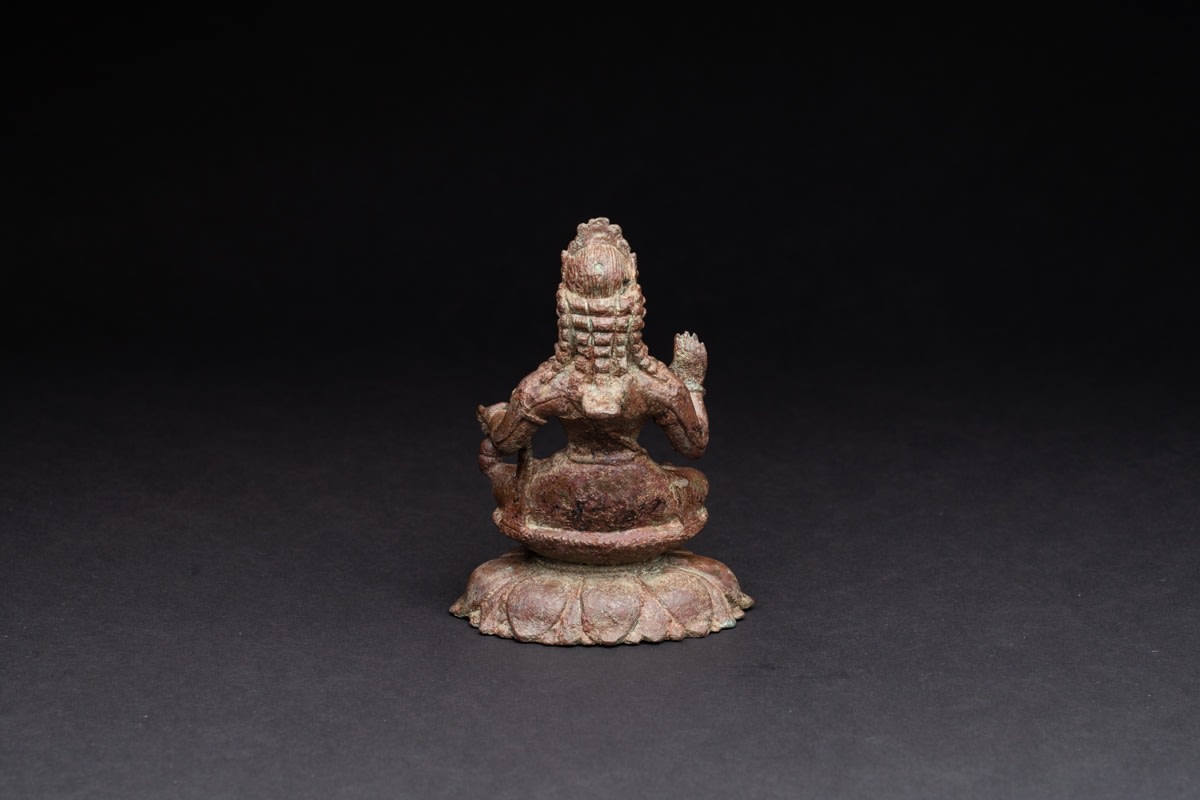Gandharan Silver-Inlaid Bronze Figure of the Bodhisattva Avalokitesvara, 6th Century CE - 8th Century CE
Bronze
height 12.7 cm
height 5 in
height 5 in
H.1090
Further images
The ancient region of Gandhara was strategically situated at a confluence of trading paths along the Silk Route. Located in modern day nations of Afghanistan and Pakistan, this area also...
The ancient region of Gandhara was strategically situated at a confluence of trading paths along the Silk Route. Located in modern day nations of Afghanistan and Pakistan, this area also had access routes to the Arabian Sea. The land of Gandhara was flooded in cultural influences ranging from Greece to China. After the conquests of Alexander the Great, the creation of Greco-Bactrian kingdoms, and the general Hellenization of the subcontinent, Western aesthetical tastes became prominent. Greek influence began to permeate into the arts and culture. After the fall of the Bactrians, the land was ruled by a combination of Scythians and Parthians until they in turn were pushed out by the nomadic Kushan tribe. Having migrated from western China, who settled in the region and went on to establish their own dynasty.The area flourished under the Kushan and their greatest king, Kanishka, who traditionally given credit for further spreading the philosophies of Buddhism throughout central Asia and into China. This period is viewed as the most important era in the early history of Buddhism. Some of the earliest representations of the Buddha in his human form date to the Kushan era, as do the first depictions of Bodhisattvas. Gandharan sculptors based their images of the Buddha on Greco-Roman models, depicting Him as a stocky and youthful Apollo, complete with stretched earlobes and loose monastic robes similar to a Roman toga. The extraordinary artistic creations of Gandhara reveal an ancient link between the East and West. Their influence extended to the rest of Western-Central Asia, to areas such as Hadda, Bamiyan, and Swat Valley.
In the Buddhist religion, Bodhisattvas are souls who have attained enlightenment and no longer need to reincarnate, but forsake nirvana and choose to come back in order to alleviate the suffering of others. They act as mediators on behalf of mankind to historical or Primordial Buddhas. Bodhisattvas are traditionally depicted dressed in royal attire, festooned with jewelry and a crowns featuring an image of one of the Primordial Buddha, revealing their cosmic lineage. One of the most popular Bodhisattvas, Avalokitesvara is worshiped throughout the Buddhist world. He is first mentioned in the Lotus Sutra, which explains his flower attribute. Although he is known by many names -- Chenrezi in Tibet, Lokesvara in Nepal, Kannon in Japan, Guanyin in China -- he is universally loved for his benevolence towards all human beings. As the guiding deity of the Gelukpa monastic order, the Dalai Lama is considered to be an emanation of this Bodhisattva.
This magnificent Gandharan bronze sculpture of Avalokitesvara is an early representation of this most beloved Bodhisattva. He sits high upon a lotus throne, holding the palm of his right hand in the air and the neck of a flask in his left. He wears a simple monastic robe that clings to his legs, showing his bare chest. Incised lines has been added to suggest the folds of the cloth. Despite his humble attire, he is adorned with a beaded necklace, various armbands and bracelets, and an elaborate crown. His eyes and his urna are inlaid with silver. The overall aesthetics of this work do not vary significantly from similar sculptures produced in Tibet and Nepal several centuries later, revealing a formal link between the art of Gandhara and later Buddhist styles. Another item with a similar lotus pedestal was presented at Christie’s New York (15 March 2016, Lot 44).
In the Buddhist religion, Bodhisattvas are souls who have attained enlightenment and no longer need to reincarnate, but forsake nirvana and choose to come back in order to alleviate the suffering of others. They act as mediators on behalf of mankind to historical or Primordial Buddhas. Bodhisattvas are traditionally depicted dressed in royal attire, festooned with jewelry and a crowns featuring an image of one of the Primordial Buddha, revealing their cosmic lineage. One of the most popular Bodhisattvas, Avalokitesvara is worshiped throughout the Buddhist world. He is first mentioned in the Lotus Sutra, which explains his flower attribute. Although he is known by many names -- Chenrezi in Tibet, Lokesvara in Nepal, Kannon in Japan, Guanyin in China -- he is universally loved for his benevolence towards all human beings. As the guiding deity of the Gelukpa monastic order, the Dalai Lama is considered to be an emanation of this Bodhisattva.
This magnificent Gandharan bronze sculpture of Avalokitesvara is an early representation of this most beloved Bodhisattva. He sits high upon a lotus throne, holding the palm of his right hand in the air and the neck of a flask in his left. He wears a simple monastic robe that clings to his legs, showing his bare chest. Incised lines has been added to suggest the folds of the cloth. Despite his humble attire, he is adorned with a beaded necklace, various armbands and bracelets, and an elaborate crown. His eyes and his urna are inlaid with silver. The overall aesthetics of this work do not vary significantly from similar sculptures produced in Tibet and Nepal several centuries later, revealing a formal link between the art of Gandhara and later Buddhist styles. Another item with a similar lotus pedestal was presented at Christie’s New York (15 March 2016, Lot 44).













